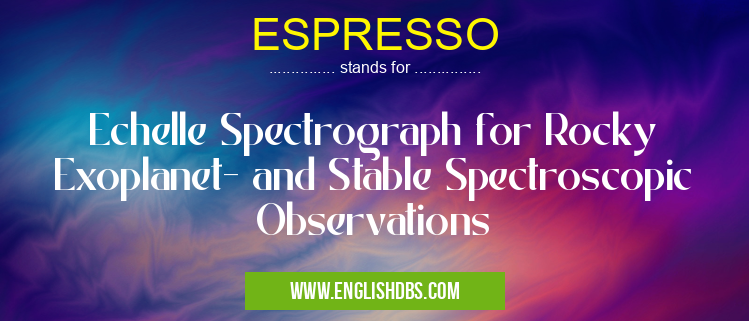What does ESPRESSO mean in PHYSICS
ESPRESSO stands for Echelle Spectrograph for Rocky Exoplanet- and Stable Spectroscopic Observations. It is a highly specialized tool designed to look for rocky exoplanets (planets outside our solar system) and measure other aspects of stellar activity. ESPRESSO is intended to allow us to explore the secrets of the universe by detecting small changes in a star's spectrum that could indicate an orbiting exoplanet or the presence of faint, cool stars. As such, it offers a unique opportunity for astronomers to observe these distant, unseen worlds in more detail than ever before

ESPRESSO meaning in Physics in Academic & Science
ESPRESSO mostly used in an acronym Physics in Category Academic & Science that means Echelle Spectrograph for Rocky Exoplanet- and Stable Spectroscopic Observations
Shorthand: ESPRESSO,
Full Form: Echelle Spectrograph for Rocky Exoplanet- and Stable Spectroscopic Observations
For more information of "Echelle Spectrograph for Rocky Exoplanet- and Stable Spectroscopic Observations", see the section below.
Essential Questions and Answers on Echelle Spectrograph for Rocky Exoplanet- and Stable Spectroscopic Observations in "SCIENCE»PHYSICS"
What is ESPRESSO?
ESPRESSO stands for Echelle Spectrograph for Rocky Exoplanet- and Stable Spectroscopic Observations. It is a high-resolution optical spectrograph that is used to measure the radial velocities (RV) of stars and provides the most precise data on exoplanet search and characterization.
What does ESPRESSO measure?
ESPRESSO measures very small increments in stellar radial velocity (RV), which can be used to detect planetary mass companions orbiting around stars. This technique is known as the radial velocity method, which has been successfully applied to detect exoplanets over the past two decades.
How precisely can ESPRESSO measure changes in RV?
ESPRESSO can measure RV with a precision of up to 0.1 m/s, making it one of the most precise instruments available for this type of observation.
Does ESPRESSO provide information about the structure and composition of exoplanets?
Yes, by measuring radial velocities, we can infer information about orbital parameters such as period, eccentricity, inclination, semi-amplitude and so on. Also, by monitoring the spectra of stellar systems hosting exoplanets over long timescales it is possible to determine additional parameters like star spots or binary components.
How much light does ESPRESSO collect?
Thanks to its unique design consisting of two telescopes working together as an interferometer called U-shaped fibre mode (UF) and three independent arms working simultaneously (TRIPLE mode) it collects light five times more efficiently than any other existing instrument before it.
Is there a way to use ESPRESSO without taking into account atmospheric effects?
Yes, the use of Adaptive Optics Modulated (AMOD) allows users to overlook atmospheric effects by simulating a telescope that operates at infinitely high resolution as if located above Earth's atmosphere. This feature also allows usage to achieve even higher precision measurements when observing bright objects.
What kind of object can be observed with ESPRESSO?
Objects observable with ESPRESSO are typically bright sources like small stars or those located close to our Solar System such as Proxima Centauri or Barnard’s star among others due its high precision capabilities that rely on them being already bright enough in order for meaningful detection limits to be reached during observations.
Can I observe non-stellar objects using ESPRESSO?
Yes, through its observatory located at Cerro Paranal in Chile, which hosts four 8m Unit Telescopes (UTs), ESPRESSO allows observers access not only stellar objects but also targets from other fields including solar system bodies such as comets and asteroids or active galactic nuclei among others provided they are visible from ESPRESSOs location.
